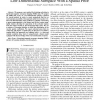Free Online Productivity Tools
i2Speak
i2Symbol
i2OCR
iTex2Img
iWeb2Print
iWeb2Shot
i2Type
iPdf2Split
iPdf2Merge
i2Bopomofo
i2Arabic
i2Style
i2Image
i2PDF
iLatex2Rtf
Sci2ools
TMI
2008
2008
Classification of fMRI Time Series in a Low-Dimensional Subspace With a Spatial Prior
We propose a new method for detecting activation in functional magnetic resonance imaging (fMRI) data. We project the fMRI time series on a low-dimensional subspace spanned by wavelet packets in order to create projections that are as non-Gaussian as possible. Our approach achieves two goals: it reduces the dimensionality of the problem by explicitly constructing a sparse approximation to the dataset and it also creates meaningful clusters allowing the separation of the activated regions from the clutter formed by the background time series. We use a mixture of Gaussian densities to model the distribution of the wavelet packet coefficients. We expect activated areas that are connected, and impose a spatial prior in the form of a Markov random field. Our approach was validated with in vivo data and realistic synthetic data, where it outperformed a linear model equipped with the knowledge of the true hemodynamic response.
| Added | 15 Dec 2010 |
| Updated | 15 Dec 2010 |
| Type | Journal |
| Year | 2008 |
| Where | TMI |
| Authors | François G. Meyer, Xilin Shen |
Comments (0)

